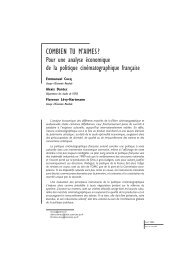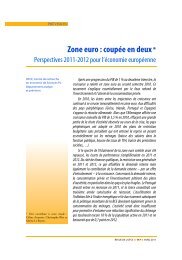direct multi-step estimation and forecasting - OFCE - Sciences Po
direct multi-step estimation and forecasting - OFCE - Sciences Po
direct multi-step estimation and forecasting - OFCE - Sciences Po
You also want an ePaper? Increase the reach of your titles
YUMPU automatically turns print PDFs into web optimized ePapers that Google loves.
Direct <strong>multi</strong>-<strong>step</strong> <strong>estimation</strong> <strong>and</strong> <strong>forecasting</strong><br />
˜Υ h has, therefore, some potential when ̂Υ is badly biased for Υ, or when E[x T +1 | x T ] = Ψx T but<br />
E[x T +h | x T ] ≠ Ψ h x T . However, they remark also that in stationary processes, misspecification<br />
of the DGP is not sufficient to advocate the use of DMS, since ̂Υ is the OLS <strong>and</strong> ˜Υ h converges<br />
towards the unconditional expectation with Υ h tending to zero as h increases. Hence, increasing<br />
divergence between ̂Υ <strong>and</strong> ˜Υ h is unlikely. Moreover, DMS is inefficient in small samples, so<br />
that if ɛ t ∼ IN ( 0, σ 2 ɛI n<br />
)<br />
, biases are unlikely to be enough for a gain to appear. Thus, Clements<br />
<strong>and</strong> Hendry note that if ɛ t follows a negative moving average, there may be some potential for<br />
DMS. They derive a taxonomy of forecast errors <strong>and</strong> show that the only terms in common for<br />
both methods are those of error accumulation, namely ∑ h−1<br />
i=0 Υi ɛ T +h−i in the framework above.<br />
Simulating the small sample <strong>estimation</strong> biases, they show, for several stationary values—0, 0.4<br />
<strong>and</strong> 0.8—of the autoregressive coefficient in a univariate AR(1) process without intercept, that for<br />
sample sizes ranging from 10 to 100, the two <strong>step</strong> ahead DMS does not yield better estimates of<br />
the powered coefficient than the squared IMS.<br />
This result is specific to finite samples as Chevillon <strong>and</strong> Hendry (2005) show: when estimating<br />
(16) with an additional drift by OLS <strong>and</strong> (17), with a drift also, by GMM, with a HAC covariance<br />
matrix estimator, DMS is asymptotically more efficient than IMS in the case of stationary processes<br />
with positive slope. Indeed, in the univariate case, denoting by ê h <strong>and</strong> ẽ h the IMS <strong>and</strong> DMS forecast<br />
errors at horizon h using GMM <strong>estimation</strong>, <strong>and</strong> ρ the slope coefficient, these authors show that:<br />
h ( E [ ê 2 [ẽ2 ] ) 2ρ<br />
h]<br />
/E h − 1ρ →<br />
h→∞ (1 − ρ 2 ) (2 − ρ) ,<br />
the latter being of the same sign as ρ, as long as |ρ| < 1. In the case of integrated processes, this<br />
result collapses <strong>and</strong> IMS always dominates DMS.<br />
A Monte Carlo analysis by Clements <strong>and</strong> Hendry, of the forecasts from the ‘nonseasonal Holt–<br />
Winters Model’ illustrates the relative behaviours of the IMS <strong>and</strong> DMS techniques in their framework.<br />
The data is generated by the sum of unobserved components for the trend, intercept <strong>and</strong><br />
irregular elements:<br />
y t = µ t + ε t ,<br />
µ t = µ t−1 + β t + δ 1t ,<br />
β t = β t−1 + δ 2t .<br />
30








